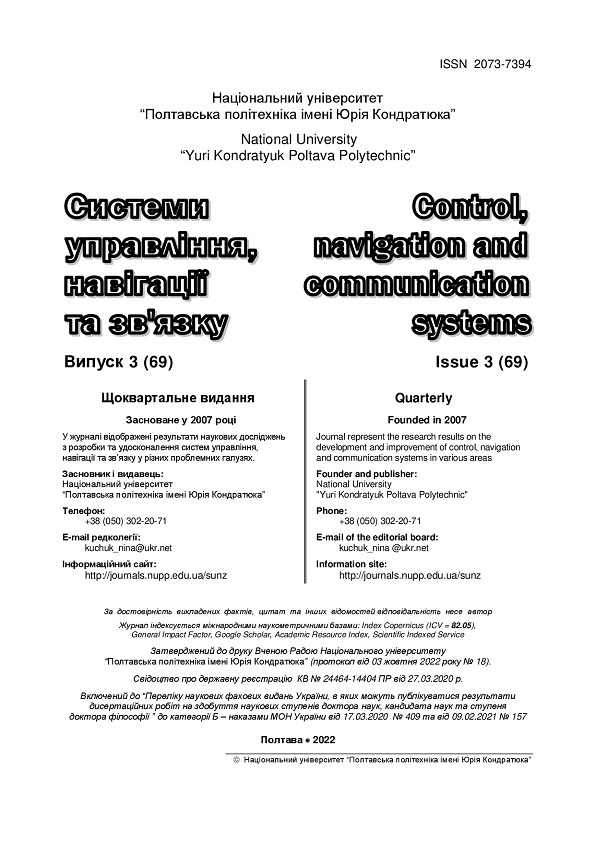CAUSAL MODEL OF THE PROCESS OF CONSTRUCTING EXPLANATIONS IN THE INFORMATION SYSTEM
DOI:
https://doi.org/10.26906/SUNZ.2022.3.099Keywords:
intellectual system, explanation, decision-making process, temporality, causality, temporal rulesAbstract
The subject matter of the article is the processes of formation of explanations regarding the decisions made in the intellectual information system. The goal is to develop a model for the process of constructing detailed explanations regarding the decision made by an intelligent information system based on causal dependencies between known states of an intelligent information system for more efficient use of the resulting solution in solving practical user problems. Tasks: temporal structuring of the process of formation of explanations in the intellectual information system; development of a causal model of the process of formation of explanations. The approaches used are: approaches to the construction of causal dependencies, approaches to the use of temporal dependencies in decision-making processes. The following results are obtained. The structure of the process of constructing explanations is determined, taking into account the temporal aspect. On the basis of the obtained structure, a causal model of the process of constructing explanations in an intelligent information system has been developed. Conclusions. The scientific novelty of the obtained results is as follows. A model of the process of constructing explanations regarding the sequence of actions for the formation of decisions in an intelligent information system is proposed, containing a set of states of the decision-making process ordered by a set of temporal rules, as well as a set of deterministic and probabilistic causal rules that determine cause-and-effect relationships between the states of the decision-making process. The model is focused on construction of explanations in the form of a sequence of causal rules that connect both successive states of the decision-making process in time, and states between which there are sequences of other states. The proposed model makes it possible to refine the explanation by presenting a generalized causal dependence through a complex of cause-and-effect dependencies between intermediate states of the decision-making processDownloads
References
Fararni K., Aghoutane B., Riffi J., Abdelouahed S. (2020). Comparative Study on Approaches of Recommendation Systems. Embedded Systems and Artificial Intelligence, 753-764. doi: 10.23919/AEIT.2018.8577311. Available at: https://www.researchgate. net/publication/340497029_Comparative_Study_on_Approaches_of_Recommendation_Systems.
Izquierdo-Castillo, J. (2015). The new media business concept led by Netflix: A study of the model and its projection into the Spanish market. El Profesional de la Informacion, 24 (6), 819-826. 24. 819. doi: 10.3145/epi.2015.nov.14. Available at: https://recyt.fecyt.es/index.php/EPI/article/view/epi.2015.nov.14.
Chalyi, S., Leshchynskyi, V., Leshchynska, I. (2019). Method of forming recommendations using temporal constraints in a situation of cyclic cold start of the recommender system. EUREKA: Physics and Engineering, 4, 34–40. doi: https://doi.org/10.21303/2461-4262.2019.00952 . Available at: http://eu-jr.eu/engineering/article/view/952/934.
Tsai C., Brusilovsky P. (2019). Explaining recommendations in an interactive hybrid social recommender. Proceedings of the 24th International Conference on Intelligent User Interfaces (IUI '19), 391-396. doi: 10.1145/3301275.3302318. Available at: https://dl.acm.org/doi/abs/10.1145/3301275.3302318.
Chalyi S., Leshchynskyi V., Leshchynska I. (2019). Моделювання пояснень щодо рекомендованого переліку об’єктів з урахуванням темпорального аспекту вибору користувача. Системи управління, навігації та зв’язку, 6 (58), 97-101. – doi:https://doi.org/10.26906/SUNZ.2019.6.097.
Chalyi, S., Leshchynskyi, V. (2020). Method of constructing explanations for recommender systems based on the temporal dynamics of user preferences. EUREKA: Physics and Engineering, 3, 43-50. doi: 10.21303/2461-4262.2020.001228.
Чалий С. Ф. Реляційно-темпоральна модель набору сутностей предметної області для процесу формування рішення в інтелектуальній інформаційній системі / С. Ф. Чалий, В. О. Лещинський, І. О. Лещинська // Вісник Національного технічного університету "ХПІ". Сер. : Системний аналіз, управління та інформаційні технології = Bulletin of the National Technical University "KhPI". Ser. : System analysis, control and information technology : зб. наук. пр. – Харків : НТУ "ХПІ", 2022. – № 1 (7). – С. 84-89.
Adadi, A., Berrada, M. (2018) Peeking inside the black-box: a survey on explainable artificial intelligence (XAI). IEEE Access 6, 52138– 52160.
Gunning і D. Aha, (2019) “DARPA’s Explainable Artificial Intelligence (XAI) Program”, AI Magazine, Vol. 40(2), pp.44-58, doi: 10.1609/aimag.v40i2.2850.
Pearl J (2009) Causality: Models, Reasoning and Inference, 2nd ed. Cambridge University Press, USA.
Halpern J. Y., Pearl J. (2005), Causes and explanations: A structural-model approach. Part II: Explanations. The British Journal for the Philosophy of Science. Vol.56 (4). P. 889-911.
Maier M, Marazopoulou K, Jensen D (2014) Reasoning about Independence in Probabilistic Models of Relational Data. arXiv
Marazopoulou, Katerina, Maier, Marc, and Jensen, David. Learning the structure of causal models with relational and temporal dependence. In Proceedings of the Thirty-First Conference on Uncertainty in Articial Intelligence (2015).
. Levykin V., Chala O. Development of a method of probabilistic inference of sequences of business process activities to support business process management. Eastern-European Journal of Enterprise Technologies. 2018. № 5/3(95). P. 16-24. DOI: 10.15587/1729-4061.2018.142664
Чала О. В. (2020) Модель узагальненого представлення темпоральних знань для задач підтримки управлінських рішень. Вісник Національного технічного університету «ХПІ». Системний аналіз, управління та інформаційні технології. № 1(3). С. 14-18. DOI: 10.20998/2079-0023.2020.01.03.
Chala O. (2018) Models of temporal dependencies for a probabilistic knowledge base. Econtechmod. An International Quarterly Journal. Vol. 7, No. 3. P. 53 – 58.




